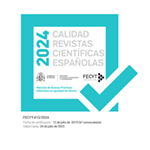Places of memory and repression in Mexico: Tlatelolco, Military Camp Number 1, and Lecumberri
Abstract
The present work accounts for three social frameworks of collective memory in Mexico. These frameworks contain significant events for a group or society. In them past experiences are meant, and in their exploration these meanings are narrated and recovered. In all three spaces, tragic and painful events and experiences took place. The first of these was the Square of the Three Cultures, Tlatelolco, site of the 1968 student massacre. The second was Military Camp Number 1, which, in addition to being a military facility, became the largest clandestine prison, where dozens of students and guerrillas arrived. The third was The Black Palace of Lecumberri, a jail where some of the 1968 detainees ended up. These three sites contain a collective memory of repression. Tlatelolco, because there is recorded a massacre, the bloodiest in the recent past. In Military Camp Number 1, the steps of those who will later disappear are lost. Lecumberri, because it was a prison where political prisoners were detained and they were cruelly treated. Exploring these three sites makes it possible to have another look at the Mexican 20th century.Downloads
Publication Facts
Reviewer profiles N/A
Author statements
- Academic society
- N/A
- Publisher
- Grupo de Investigación Cultura Digital y Movimientos Sociales. Cibersomosaguas
Article download
License
In order to support the global exchange of knowledge, the journal Teknokultura is allowing unrestricted access to its content as from its publication in this electronic edition, and as such it is an open-access journal. The originals published in this journal are the property of the Complutense University of Madrid and any reproduction thereof in full or in part must cite the source. All content is distributed under a Creative Commons Attribution 4.0 use and distribution licence (CC BY 4.0). This circumstance must be expressly stated in these terms where necessary. You can view the summary and the complete legal text of the licence.













